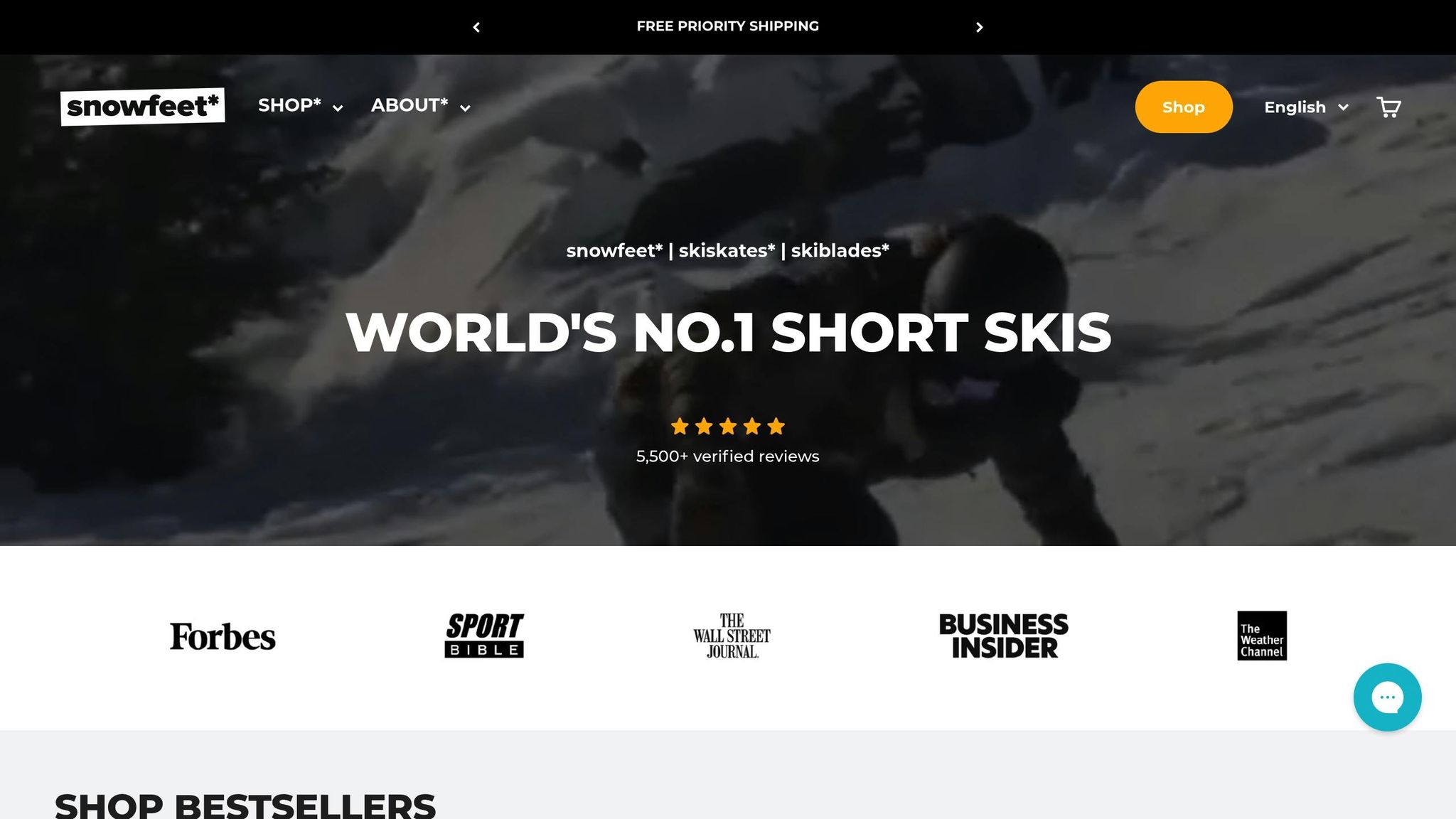スノーボードから始めるべきか、それともSnowfeet*を試すべきか迷っていますか?こちらが簡単な概要です:
- スノーボード:大きくて重く、専用のブーツが必要です。伝統的な斜面に最適ですが、習得に時間がかかり、装備も多く必要です。フルセットで500ドル以上かかります。
- Snowfeet*:軽量でコンパクト、普通の冬用ブーツで使えます。習得が簡単で携帯性に優れ、多用途 - 裏庭でも使えます。価格は150ドルから。
主な違い:
- 習得の難易度:Snowfeet*は初心者に優しく、雪上のローラーブレードのような感覚です。スノーボードは習得に時間がかかります。
- 携帯性:Snowfeet*はバックパックに収まり、スノーボードは追加の収納スペースが必要です。
- コスト:Snowfeet*はスノーボードに比べて予算に優しいです。
- 地形:Snowfeet*はゲレンデ、トレイルなどで使えますが、スノーボードは主にスキーリゾート向けです。
| 特徴 | スノーボード | Snowfeet* |
|---|---|---|
| コスト | 500ドル以上 | 150ドル以上 |
| サイズ | 4~5フィートの長さ | 15~47インチ |
| 必要なブーツ | 専用ブーツ | 通常の冬用ブーツ |
| 習得の難易度 | より急斜面 | より簡単 |
| 携帯性 | かさばる | バックパックに収まる |
| 地形の選択肢 | スキーリゾートのみ | ゲレンデ、トレイル、裏庭 |
結論:シンプルで持ち運びやすく初心者に優しいものが欲しいなら、Snowfeet*を選びましょう。スノーボードに本気で取り組み、予算があるなら、伝統的なスノーボードも素晴らしい選択肢です。どちらがあなたのスタイルとニーズに合うか、続きを読んで確認してください!
スノーボーダーがSnowfeet*を試す|どのSnowfeet*ショートスキーがベスト?|Snowblades 44、65、99レビュー

スノーボードと Snowfeet* 製品の主な違い
従来のスノーボードと Snowfeet* 製品のどちらを選ぶかは、乗り心地、持ち運びやセットアップのしやすさ、そして初心者に優しいかどうかにかかっています。
スノーボードと Snowfeet* の乗り心地
雪上での体験について話しましょう。従来のスノーボードでは両足が一つのボードに固定され、横向きの姿勢を強いられます。この姿勢は特に初心者にはぎこちなく感じられることがあります。スノーボードは硬いセットアップのため学習曲線があり、最初はバランスやコントロールが難しいことがあります。
さて、Snowfeet* 製品、例えばMini Ski Skatesは全く違う雰囲気を提供します。前を向き、各足が独立して動くことができ、ローラーブレードのような感覚で雪上を滑れます。このセットアップは多くの人にとってより自然に感じられ、特に冬のスポーツ初心者にとっては調整しやすく、スピードのコントロールや最初のうちの失敗からのリカバリーが簡単です。
装備の持ち運びとセットアップ
従来のスノーボードは文字通り多くの荷物が伴います。ボード、バインディング、そしてあのかさばる専門ブーツ。場所を取る上に、輸送にはルーフラックや大きなバッグが必要なことが多いです。
一方、Snowfeet* 製品はシンプルさが特徴です。軽量でコンパクト、バックパックにすっぽり収まります。かさばる装備と格闘したり、収納を心配する必要はありません。準備にかかる時間が減り、実際に雪を楽しむ時間が増えます。
各オプションの学びやすさ
スノーボードの横向きの姿勢は、学習を遅くしイライラさせることがあります。バランスとターンのコツを掴むには時間がかかります。
Snowfeet* 製品ははるかに扱いやすいです。前向きのデザインと独立した足の動きが直感的で、体が適応しやすくなっています。さらに、スキーリゾートに縛られません。地元の丘やハイキングコース、さらには自宅の庭でも練習できます。プレッシャーも大勢の人もなく、この柔軟性が自分のペースで自信を築くのに役立ちます。
並べて比較:スノーボード vs Snowfeet*
この2つの選択肢がどのように比較されるかを簡単に見てみましょう:
| 特徴 | 従来のスノーボード | Snowfeet* 製品 |
|---|---|---|
| 重量とサイズ | 重くてかさばり、追加の装備や収納が必要 | 軽量でコンパクト - バックパックに収まる |
| ブーツの要件 | 専門のスノーボードブーツが必要 | 通常の冬用ブーツやスノーボードブーツに対応 |
| 習得の難易度 | 硬い姿勢は初心者には難しいことがある | 前向きのデザインは自然で覚えやすい |
| 携帯性とセットアップ | 運搬とセットアップにより多くの時間とスペースが必要 | 素早く簡単にセットアップでき、どこへでも持っていける |
| 地形の柔軟性 | スキーリゾートに最適 | 斜面、トレイル、裏庭、そり滑りの丘でも使える |
初心者にとって、Snowfeet*製品はより簡単で親しみやすい選択肢に感じられます。運搬が楽で学びやすく、余計なギアのトラブルなしに楽しむことに集中できます。斜面を滑る時も裏庭で遊ぶ時も、Snowfeet*なら冬のスポーツに気軽に飛び込めます。
なぜSnowfeet*が初心者により適しているのか
冬のスポーツが初めての方には、Snowfeet*製品が優れた選択肢です。従来のスノーボードに比べて学習が簡単で、余計な複雑さなく斜面を楽しめます。
軽量で持ち運びが簡単
従来のスノーボードは重くてかさばるバインディングが必要で、専用のブーツも求められます。さらに運搬にはルーフラックや大きなバッグが必要になることが多いです。一方、Snowfeet*は耐久性のあるプラスチック製で軽量かつ持ち運びが簡単です。コンパクトなサイズなので普通のバックパックに入れられ、突然の雪の日にもぴったりです。
初心者に優しい特徴
Snowfeet*は初心者にとって画期的です。従来のスノーボードのように両足を横向きに固定するのではなく、Snowfeet*は前向きで足を独立して動かせます。ローラーブレードのような感覚ですが、雪の上で楽しめます。さらに、通常の冬用ブーツやスノーボードブーツが使えるので、専用の靴を買う費用も節約できます。短いデザインはより鋭く素早いターンを可能にし、調整しやすく自信をつけながら学べます。
ほぼどこでも使える
従来のスノーボードは通常、スキーリゾートや指定された斜面に限定されます。しかし、Snowfeet*はさまざまな場所で使えます。裏庭に雪がありますか?完璧です。ハイキングコースや地元の公園で試したいですか?どうぞ。多用途なので、十分な雪があればほぼどこでも練習できます。
なぜ初心者に短いスキーが理にかなっているのか
長いスキーは安定性を提供するかもしれませんが、特に初心者の場合は操作がずっと難しくなります。Snowfeet*のような短いスキーは操作が簡単で、力や持久力をまだ鍛えている段階でも楽に扱えます。また、重心を安定させることでバランスを保ちやすくなり、大きすぎるギアに苦労するよりも基本をマスターすることに集中できます。
Snowfeet* の製品、例えばミニスキー・スケート(38 cm)やSkiskates(44 cm)は初心者を念頭に設計されています。そのコンパクトなデザインは自然な動き、素早い習得、簡単な携帯性を促進し、冬の冒険を楽しくストレスフリーにします。敏捷性とコントロールを求めるなら、Snowfeet* は素晴らしい出発点です。
sbb-itb-17ade95
Snowfeet* と主要なスキー・スノーボードブランドの比較
Snowfeet* と伝統的なウィンタースポーツギアを選ぶ際には、両者の比較が役立ちます。Rossignol、Atomic、Elan、Salomon といった確立されたブランドは、何十年もウィンタースポーツ愛好者に信頼されています。一方、Snowfeet* は特に初心者やカジュアルなライダーに向けて、シンプルで楽しい新しい選択肢を提供します。
価格について話しましょう。伝統的なスキーやスノーボードは高価で、すべての付属品を含めるとセットアップに800ドルから1,500ドルかかることが多いです。一方、Snowfeet* は財布に優しく、製品価格は150ドルから300ドルの範囲です。さらに、伝統的なギアは専門のブーツ、ビンディング、プロのフィッティングサービスに追加費用がかかります。Snowfeet* は日常の冬用ブーツとシームレスに連携し、時間とお金を節約します。
重量も大きな要素です。伝統的なスノーボード(ビンディング込み)は通常9〜15ポンドの重さがあります。それを運ぶにはルーフラックや大きなバッグが必要になることが多いです。一方、Snowfeet* 製品は非常に軽量で3ポンド未満、バックパックに収まるほどコンパクトです。これにより、混雑したロッジの中を移動したり、狭いスペースに収納したり、公共交通機関に乗るのも夢のように簡単になります。
メンテナンス?Snowfeet* はここでもシンプルさを保ちます。伝統的なスキーやスノーボードは、良好なパフォーマンスを維持するために定期的なワックスがけ、エッジ調整、ビンディングの調整が必要です。耐久性のあるプラスチック製の Snowfeet* 製品は、最小限の手入れでさまざまな雪の条件に対応できるよう設計されています。また、伝統的なビンディングは専門的な調整が必要なことが多いですが、Snowfeet* のビンディングは素早く簡単にセットアップでき、数分で滑走準備が整います。
完全比較:Snowfeet* vs. 主要ブランド
| 特徴 | Snowfeet* | 伝統的なブランド(Rossignol、Atomic、Elan) |
|---|---|---|
| 価格帯 | $150 - $300 | 300ドル - 1,500ドル以上(スキーのみ) |
| 総セットアップコスト | $150 - $300 | 800ドル - 1,500ドル以上 |
| 重量 | 3 ポンド未満 | 9 - 15 ポンド(ビンディング付き) |
| 携帯性 | バックパックに収まる | ルーフラックや大きなバッグが必要 |
| ブーツの互換性 | 通常の冬用ブーツで使用可能 | 専用ブーツが必要 |
| メンテナンス | メンテナンスが少ない | 定期的なワックスがけ/チューニングが必要 |
| 習得の難易度 | 初心者に優しい | 習得にやや時間がかかる |
| セットアップ時間 | 迅速かつ簡単 | プロによるフィッティングが必要な場合が多い |
Rossignol、Atomic、Elanのような伝統的なブランドが熟練スキーヤーやスノーボーダー向けであるのに対し、Snowfeet*は初心者にとって手軽で軽量、そして予算に優しい選択肢として際立っています。Snowfeet*が冬のスポーツ界で注目されているのは、シンプルさ、携帯性、そして楽しさにこだわっているからです。
適切なSnowfeet*モデルの選び方
Snowfeet*が従来のスキーやスノーボードとどう違うかがわかったら、次はどのモデルがあなたに最適かを見つけましょう。スキルレベルや地形に合わせたオプションが揃っているので、正しいものを選べばゲレンデでの楽しさがまったく変わります。
Snowfeet* 製品オプション
Snowfeet*は、用途やライダーに合わせて設計された3つの主要な製品タイプを提供しています。
- Snowfeet Mini Ski Skates:長さわずか38cm、価格は150ドルからで、初心者に最適です。とても携帯しやすく(バックパックに入ります!)、どんな冬用シューズにも対応します。ハイキングトレイルやクロスカントリーパス、さらには自宅の裏庭で遊ぶのにもぴったりです。
- Skiskates:これらは「PRO」バージョンと考えてください。長さは44 cmで、価格は390ドルから、木製コアを採用しスピードと精度が向上しています。これは経験豊富なライダーに最適で、ショートスキーの敏捷性を求めつつ、整地された斜面でのパフォーマンスを高めたい方にぴったりです。
- Skiblades:これはSkiskatesと伝統的なスキーの中間に位置します。65 cm(450ドル)、99 cm(490ドル)、120 cm(690ドル)の3つの長さがあります。Skibladesはカービング、スノーパーク、さらにはパウダーもこなせる素晴らしいモデルです。ただし、120 cmモデルはスキーブーツが必要で、短いモデルはブーツの選択肢がより柔軟です。
適切なモデルの選び方
決めるときは、主に3つのことを考えましょう:どこで滑るか、経験レベル、そしてブーツの好みです。
- スキーリゾートや整地された斜面に限定するなら、SkiskatesかSkibladesが堅実な選択です。圧雪された雪や急な斜面も楽にこなせます。
- バックカントリートレイルやカジュアルな楽しみには、Mini Ski Skatesが軽量で持ち運びやすいです。
- ローラーブレードやアイススケートの経験があるなら、Skiskatesは自然にフィットするでしょう。新しいことに挑戦したいスノーボーダーには、短めの65 cm Skibladesがショートスキーへの良い入り口になるかもしれません。
雪の状態も重要です。Snowfeet*のギアは整地された雪で輝きますが、深いパウダーには最適ではありません。とはいえ、パウダーに挑むなら、長めのSkiblades(120 cmモデルなど)が短いものよりも優れたパフォーマンスを発揮します。
追加アイテムとブーツの互換性
Snowfeet*を最大限に楽しむには、適切なブーツとアクセサリーを選ぶことが重要です。簡単にまとめると:
- Mini Ski Skates:どんな冬用シューズやスノーボードブーツでも使えます。
- Skiskates:スキーとスノーボードブーツの両方に対応しています。
- 120 cm Skiblades:スキーブーツ専用です。
ブーツを選ぶときは、防水性があり強い足首サポートのあるものを選びましょう。足が小さい場合、スノーボードブーツはSnowfeet*のバインディングにより適していることが多いです。
Snowfeet*はまた、3種類のバインディングを提供しています:
- Basic bindings:予算に優しいですが、大きめのスノーボードブーツには合わない場合があります。
- Standard bindings:より強力で、ぴったりフィットするための追加ストラップが付いています。
- Pro X bindings:最高級の快適さと調整性で、ほぼすべてのブーツにフィットします。
お忘れなく!Liquid WaxはSnowfeet*をスムーズに滑らせ、雪の付着を防ぐために必須です。エッジ研ぎ用の石は金属エッジのメンテナンスに役立ちます(リゾートでは重要です)、そして予備のストラップを持っていると、何かが壊れたときに助かります。
結論:あなたの冬の楽しみに合ったものを選ぼう
初めての冬用ギア選びは圧倒される必要はありません。確かにBurtonやRossignolのようなブランドの伝統的なスノーボードは目を引くかもしれませんが、Snowfeet*製品は特に初心者にとって、よりシンプルで柔軟に冬のスポーツに飛び込める方法を提供します。
考慮すべきポイント:Snowfeet*は5,500件以上の検証済みレビューを誇り、評価は驚異の4.9/5スター。気軽に楽しみたいなら38cmのMini Ski Skatesが150ドル、もっと冒険したいなら44cmのSkiskatesが390ドル。どちらもコンパクトでバックパックに収まり、既に持っているブーツで使えます。
"これまでで間違いなく最高の買い物の一つです。" – Vanessa, UK
人気の秘密?多用途性です。特定の地形に限定され、専用ブーツが必要な従来のスノーボードとは違い、Snowfeet*製品はほぼどんな環境にも適応します。整備されたゲレンデやハイキングコース、近所のそり遊びの丘までカバー。山に行く前に自宅の庭で練習することも可能です。スノーボードは習得に数週間かかることもありますが、多くのSnowfeet*ユーザーはたった一回のセッションで自信を持って滑れるようになります。
もう一つの大きな勝利は手頃な価格。ほとんどのモデルが400ドル以下で、Snowfeet*は従来のギアの高額な費用なしに冬のスポーツを楽しむ予算に優しい方法を提供します。
まずは試してみたいなら、Mini Ski Skatesが最適なスタートポイント。もう少しチャレンジしたいなら、Skiskatesがゲレンデでのパフォーマンスをアップさせてくれます。どちらも5歳の子どもからシニアまで誰でも使えるように設計されており、全国のほとんどのスキーリゾートで利用可能です。
冬の楽しみはお金がかかりすぎたり、面倒に感じる必要はありません。Snowfeet*なら、ただ装着して冒険を始めるだけです。
よくある質問
なぜSnowfeet*は従来のスノーボードより初心者にとって良い選択なのでしょうか?
Snowfeet*は従来のスノーボードと比べて初心者に嬉しい特長がいくつかあります。まず、軽量でコンパクトなデザインが扱いやすく、コントロールも簡単で持ち運びも楽々。スノースポーツを始めたばかりの人にとっては大きな変化をもたらします。かさばるスノーボードやスキーとは違い、これらの小さなギアは普通のバックパックにすっぽり収まるので、思い立ったらすぐにゲレンデへ行けます。
もう一つの大きなメリット?特別なギアに大金を使う必要はありません。Snowfeet*は普通の冬用シューズやスノーボードブーツで使えるので、シンプルで予算に優しいです。小さめのサイズは初心者がバランスを取りやすく、基本的な動きを早く習得できるのもポイント。つまり、学びながらのフラストレーションが減り、楽しさが増えるということです。
楽しく柔軟で初心者に優しいゲレンデの楽しみ方を求めるなら、Snowfeet*は伝統的なギアに代わる素晴らしい選択肢です。
Snowfeet*はすべての種類の雪で使えますか?それとも伝統的なスノーボードと比べて特定の条件でより効果的ですか?
Snowfeet*は整備されたゲレンデ、圧雪された雪、テレインパークに最適です。軽量設計と携帯性により、素早いターンや機敏な動きが楽しめます。特に初心者や、伝統的な雪用具の代わりに楽しく使いやすいものを求める人に魅力的です。
とはいえ、Snowfeet*は約4インチ以上の深いパウダーやゆるい雪には向いていません。十分な表面積がないため、そうした条件では浮力が得られません。深いパウダーや険しいバックカントリー地形に挑むなら、Rossignol、Atomic、Elanなどのブランドの伝統的なスノーボードがより良い選択です。これらはかさばり習得に時間がかかりますが、より幅広い条件に対応できるよう設計されています。
日常のゲレンデやテレインパークでコンパクトで楽しいものが欲しいなら、Snowfeet*は間違いなく良い選択です。しかし、より深い雪や難しい地形に挑戦するなら、伝統的なスノーボードの方が適しているかもしれません。
自分のスキルレベルやニーズに合ったSnowfeet*モデルはどう選べばいいですか?
適切なSnowfeet*モデルの選び方は、あなたのスキルレベルと使い方によります。初心者には、15インチのミニスキースケートのような短めのモデルがおすすめです。扱いやすく反応も良いため、基本を学ぶのに最適です。一方、経験者なら、39インチのSnowfeetのような長めのモデルを選ぶかもしれません。これらは安定性が高く、スピードも出しやすいため、限界に挑戦したい方にぴったりです。
Snowfeet*がRossignolやAtomicのようなブランドの伝統的なスキーやスノーボードと異なるのは、その軽量でコンパクトなデザインです。持ち運びが簡単で使いやすく、あらゆるレベルのスキーヤーに適しています。初心者はスムーズな学習曲線を楽しめ、上級者も十分なスリルを味わえます。快適さ、上達したい方法、挑戦する地形を考慮して選択してください。































コメントを残す
このサイトはhCaptchaによって保護されており、hCaptchaプライバシーポリシーおよび利用規約が適用されます。